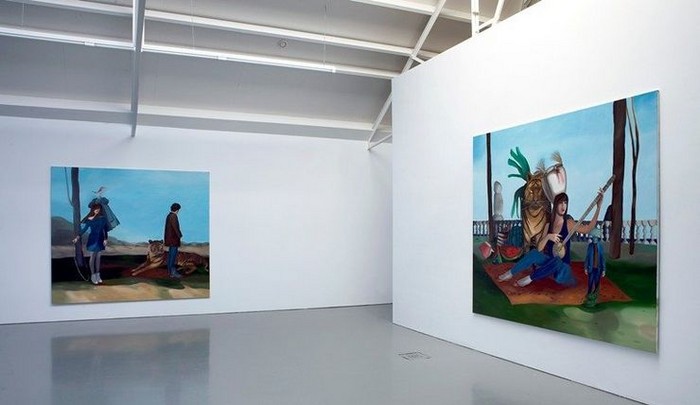Yesim Akdeniz Graf
05 Mar - 02 Apr 2011

© Yesim Akdeniz Graf
Ulalume, exhibition overview
2011
location: Galerie Fons Welters
photography by Gert Jan van Rooij
Ulalume, exhibition overview
2011
location: Galerie Fons Welters
photography by Gert Jan van Rooij
YESIM AKDENIZ GRAF
Ulalume
5 March - 2 April, 2011
The paintings of Yesim Akdeniz Graf (Izmir, Turkey, 1978) can be read as mysterious stills from a film. A narrative that slowly unfolds in the successive parts of a series, but that never fully reveals itself. Akdeniz Graf derived the title and dramatic composition for her third solo exhibition at Galerie Fons Welters from the poem by Edgar Allan Poe, whose persona wanders forlorn through an October night – ‘The skies they were ashen and sober; / The leaves they were crispèd and sere’.
The fictional character Ulalume recurs in varying guises in the exhibition, always as a self portrait of the artist. The young woman constantly appears to be caught in the moment, as in the painting Perfect Love, just before its fatal conclusion. Pursued by her waylayer, she looks up in alarm. The tension in the meticulously composed paintings is emphasised by her characteristic mode of painting and the self-contained quality of the isolated elements in the uniform landscape. Here too, it is the mysterious and dramatic atmosphere, so familiar from Poe’s Ulalume, that sets the tone. But by adopting an extreme stylisation in bright colours that appears to make the construction of the picture almost visible, she also gives the story an idiosyncratic twist of her own. In this version it is the alienation and remoteness of the image that play the primary role, rather than the drama. As if Akdeniz Graf were looking at her own work objectively, from a distance.
As in her earlier exhibitions, Akdeniz Graf too derives her imagery from a wide spectrum of visual culture: architectural icons such as the Stocklet villa in Brussels appear and allusions to the hard core films of Catherine Breillat are made. These elements recur as symbols and story-lines, and serve as metaphors in the paintings, which strike the viewer as modernist, and in places surrealistic. The references are autonomous in each work, disrupting what is otherwise a certain continuity. They thus form the pictorial order that is so characteristic of the work of Akdeniz Graf, which implicitly also reflects a certain social order and provokes questions about this young woman and her position in the world.
[Laurie Cluitmans]
Ulalume
5 March - 2 April, 2011
The paintings of Yesim Akdeniz Graf (Izmir, Turkey, 1978) can be read as mysterious stills from a film. A narrative that slowly unfolds in the successive parts of a series, but that never fully reveals itself. Akdeniz Graf derived the title and dramatic composition for her third solo exhibition at Galerie Fons Welters from the poem by Edgar Allan Poe, whose persona wanders forlorn through an October night – ‘The skies they were ashen and sober; / The leaves they were crispèd and sere’.
The fictional character Ulalume recurs in varying guises in the exhibition, always as a self portrait of the artist. The young woman constantly appears to be caught in the moment, as in the painting Perfect Love, just before its fatal conclusion. Pursued by her waylayer, she looks up in alarm. The tension in the meticulously composed paintings is emphasised by her characteristic mode of painting and the self-contained quality of the isolated elements in the uniform landscape. Here too, it is the mysterious and dramatic atmosphere, so familiar from Poe’s Ulalume, that sets the tone. But by adopting an extreme stylisation in bright colours that appears to make the construction of the picture almost visible, she also gives the story an idiosyncratic twist of her own. In this version it is the alienation and remoteness of the image that play the primary role, rather than the drama. As if Akdeniz Graf were looking at her own work objectively, from a distance.
As in her earlier exhibitions, Akdeniz Graf too derives her imagery from a wide spectrum of visual culture: architectural icons such as the Stocklet villa in Brussels appear and allusions to the hard core films of Catherine Breillat are made. These elements recur as symbols and story-lines, and serve as metaphors in the paintings, which strike the viewer as modernist, and in places surrealistic. The references are autonomous in each work, disrupting what is otherwise a certain continuity. They thus form the pictorial order that is so characteristic of the work of Akdeniz Graf, which implicitly also reflects a certain social order and provokes questions about this young woman and her position in the world.
[Laurie Cluitmans]
